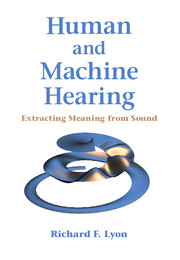Book contents
- Frontmatter
- Dedication
- Contents
- Foreword
- Preface
- Part I Sound Analysis and Representation Overview
- Part II Systems Theory for Hearing
- Part III The Auditory Periphery
- 13 Auditory Filter Models
- 14 Modeling the Cochlea
- 15 The CARFAC Digital Cochlear Model
- 16 The Cascade of Asymmetric Resonators
- 17 The Outer Hair Cell
- 18 The Inner Hair Cell
- 19 The AGC Loop Filter
- Part IV The Auditory Nervous System
- Part V Learning and Applications
- Bibliography
- Author Index
- Subject Index
- Plate section
19 - The AGC Loop Filter
from Part III - The Auditory Periphery
Published online by Cambridge University Press: 28 April 2017
- Frontmatter
- Dedication
- Contents
- Foreword
- Preface
- Part I Sound Analysis and Representation Overview
- Part II Systems Theory for Hearing
- Part III The Auditory Periphery
- 13 Auditory Filter Models
- 14 Modeling the Cochlea
- 15 The CARFAC Digital Cochlear Model
- 16 The Cascade of Asymmetric Resonators
- 17 The Outer Hair Cell
- 18 The Inner Hair Cell
- 19 The AGC Loop Filter
- Part IV The Auditory Nervous System
- Part V Learning and Applications
- Bibliography
- Author Index
- Subject Index
- Plate section
Summary
… the output (BM displacement or velocity) varies much less than the stapes input displacement or velocity, for frequencies near the best frequency. The significance of this important finding will become clearer as we proceed, but, in my opinion, it is a precursor to an automatic gain control system which seems to be built into the cochlear filters.
—“Cochlear modeling—1980,” Jont B. Allen (1981)The CARFAC's AGC Loop
Allen (1979, 1981) was among the first to describe cochlear mechanics (as opposed to neural response) as having an automatic gain control (AGC) functionality, based on modeling Rhode's observations of nonlinear mechanical response (Rhode, 1971). Kim (1984) gets much more explicit, defining the roles of the inner- and outer-hair-cell subsystems, and of the medial olivo-cochlear (MOC) efferents in the cochlea's integrated nonlinear system:
The function of the large medial OC neurons is to exert a gain control upon the biomechanics of the organ of Corti by reducing the amount of mechanical energy released from the OHCs via a synaptically mediated regulation of the membrane potential and conductance of the OHCs.
Unlike Allen's concept described in the chapter quote above, my original coupled AGC (Lyon, 1982) was not “built into the cochlear filters,” but it was otherwise not far from the concepts of Allen and Kim and our present models. That is, it was a multiplicative coupled multichannel gain control that followed a linear filterbank, rather than achieving gain variation by varying the filter damping factors.
In this chapter, we describe how the CARFAC models the MOC feedback, and more local feedback, as an AGC loop filter feeding the modeled IHCs (detectors) back to OHCs (gain effectors) described in the previous two chapters.
Compared to the simple AGC model developed in Chapter 11, the AGC loop filter in the CARFAC has several aspects that make it interesting. First, it has four one-pole smoothing filters with their outputs combined, to span a range of time constants instead of having a single characteristic time constant or corner frequency. Second, each of these four filter stages has coupling between neighboring channels—and, in a binaural or multimicrophone version, also between the two or more ears.
Information
- Type
- Chapter
- Information
- Human and Machine HearingExtracting Meaning from Sound, pp. 331 - 344Publisher: Cambridge University PressPrint publication year: 2017
